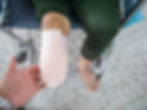What is stump? The condition and care for Stump
- Lifeforce Hub Singapore
- Jan 13, 2020
- 2 min read
Updated: Oct 5, 2023

Also known as “residual limb”, a stump is the remaining distal point of a limb after an amputation. A stump is created when a limb is amputated by cutting through skin, muscles, nerves and bones, with the bare portion of bone that is exposed at the point of amputation being smoothened out. The nerve endings will be retracted to the muscles to prevent painful sensations in the stump when the patient regains activity of the amputated limb.
After surgery, amputees will have to go through physical rehabilitation to strengthen the extremities to allow for efficient use of prosthetics. Proper care for the stump will also be taught to patients by the physical therapist.
Stump conditioning
Stump conditioning is the process of accelerating the rate at which the stump shrinks after an amputation. With proper conditioning, the stump should shrink naturally in the first few days post-surgery. Shrinkers or elastic bandages may be used to taper the stump in order to speed up this process; wrapping the stump with shrinkers or elastic bandages also helps in preventing edema, or swelling.
This is an important process as it is only after a stump has shrunk that a temporary prosthesis can be fitted to allow the patient to receive a type of postoperative care known as ambulation. After amputation, the patient is encouraged to engage in light activities as soon as possible with the help of a prosthesis that is used only for this purpose (it should be taken off when the patient sleeps). Ambulation with a temporary prosthesis offers the following benefits:
The patient is able to be active
Stump shrinkage is further accelerated
Flexion contracture (inability to fully straighten the leg) is prevented
Phantom limb pain is reduced
Stump care
Proper care for the stump is imperative for the amputee to be able to remain active. The most important thing to take note of when caring for the stump is to keep it clean and dry. Before going to bed, the patient should firstly inspect the stump to look out for changes in the condition of the skin before washing it gently with a mild soap that is not perfumed and warm water. After that, dry the stump thoroughly with a clean towel. If the skin is dry, a moisturizing cream should be applied at this point. If the patient perspires more than usual, then the stump should be cleaned more than once a day and a non-scented roll-on antiperspirant may be used as well.
The stump sock and the insides of the socket must be cleaned regularly as well.

Stump pain
Many amputees complain of stump pain after an amputation. Stump pain may be caused by a poorly fitted prosthetic socket, an amputation neuroma which is a tumor or growth that is made of nerve cells and fibers, or a spur formation which is an outgrowth of bone along the amputated end of the bone.
Phantom limb pain
A severe complication known as phantom limb pain is difficult to treat and occurs less commonly. While it is difficult to treat, treatments like simultaneous exercise of amputated limbs and their normal limb on the opposite side, stump massage, ultrasound, use of mechanical devices and finger percussion on the stump have been reported to be effective in helping alleviate phantom limb pain. Click here for Scoliosis Brace for Adults
